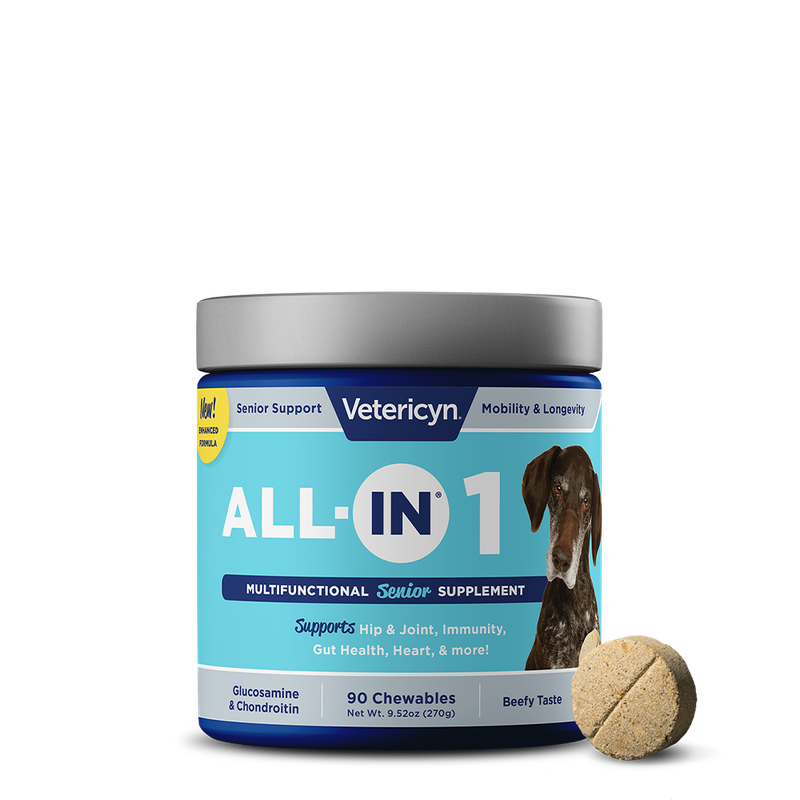Powered by Bestia Europe B.V.
Dog Arthritis Symptoms
Doesn’t it always seem like our dogs have some superhuman ability to be in the best mood all the time? Either they’re truly loving creatures, or they collectively went to a happiness seminar and are now masters of positive thinking. All joking aside, dogs are equal parts of our families because of the joy they bring. And it’s only in times of trouble—like when they’re sick or injured—that we realize their capacity for other emotions besides excitement and joy.
Unfortunately, with the highs come the lows. And witnessing your dog suffer from chronic arthritis and joint pain is definitely the lowest of lows. It’s hard not to flinch when we see dogs struggle to their feet with a bad hip or limp toward us for some petting despite the pain in their knees. Of all the ailments, arthritis in dogs is truly a heartbreaker.
To understand what your dog is going through, and to catch the signs and symptoms early, here’s everything you need to know about dog arthritis.
First Things First: What is Arthritis?
The basic definition of arthritis is inflammation of the joints—a condition that can affect both humans and dogs alike. Joint inflammation generally has one or more causes. But to understand these potential causes, we must first understand the makeup and inner workings of your dog’s joints.
The bones inside a dog’s joints are layered with cartilage (the material between bones that keeps them from rubbing together) and lubricated by joint fluid. This helps to dampen the impact of walking, running, and jumping, and allows the bones to freely glide back and forth against each other without causing friction.
So, when there’s an issue with the joint fluid, cartilage, or bones, friction can’t be prevented as effectively, which means that pain and inflammation can more easily occur. Take a look at how exactly these factors can lead to joint inflammation in your dog:
- Loss of lubricating fluid – A loss of lubricating fluid will increase friction and slowly wear away at the cartilage. Once the cartilage is gone, the bones will be in direct contact with each other, which will cause extreme discomfort and inflammation.
- Abnormal cartilage development – Because cartilage is what absorbs the impact between bones, having any abnormalities of cartilage development or a loss of cartilage will cause your dog to lose that cushioning effect. This means they’ll experience painful bone-on-bone friction during physical activity.
- Bone damage – If the bone is fractured or broken near a joint, it could regrow with an irregular shape. When this happens, the friction between bones can increase, wearing down the cartilage and causing discomfort.
Causes of Arthritis in Dogs
While the above scenarios can cause canine arthritis, how do low lubrication, abnormal cartilage, and bone damage happen in the first place?
Unfortunately, sometimes the degradation builds up over time until, one day, the condition seems to arise spontaneously. Other times, they can be linked to a specific underlying cause. For a better understanding of your dog’s arthritis, let’s take a look at the six common causes of arthritis in dogs.
- Physical trauma – Because of how sensitive all the different joint components are, any physical trauma applied directly to a joint can be enough to throw the workings into disarray. Bone fractures and joint sprains can cause a deformity within the joint itself. From there, increased friction and time are all that’s needed to inflame the joint and cause arthritis.
- Autoimmune disease – Autoimmune diseases occur when the immune system codifies a healthy cell as a pathogen. The white blood cells then attack the healthy cells, damaging whatever organ, muscle, or bone they were a part of. If the autoimmune disease targets the healthy cells that make up the joints, the cartilage, or the lubricating fluid, it could result in a nasty form of arthritis.
- Genetic predisposition – Not all dog genes are created equal. And some dogs are prone to diseases like hip dysplasia at a disproportionate amount. Larger breeds, like the Golden Retriever, German Shepherd, and Labrador Retriever, are more susceptible to developing arthritis than smaller breeds because their size creates more wear and tear on their joints. However, this doesn’t mean that smaller breeds aren’t immune.
- Joint infection – An infection at the joint can cause significant damage and lead to arthritis, especially if it’s left untreated. Joint infections can be caused by any type of bone or joint-related injury and can often have long-lasting effects, like decreased joint lubrication and degraded cartilage—both precursors to arthritis. Fortunately, these types of infections can typically be cured with broad-spectrum antibiotics administered via your veterinarian.
- Malnutrition at a young age – As your puppy grows, they develop all of their muscular and skeletal structure rapidly—typically within a span of 6-24 months. If, at any point, during this time, your puppy doesn’t receive the nutrients they need, it can lead to suboptimal bone, cartilage, and lubrication mechanism development.
For example, without enough calcium, the hip joints can’t fully develop. If these joints don’t fully develop, it becomes easier for the hip bone to pop in and out of place, resulting in a higher likelihood of hip dysplasia. If you’re a new puppy parent, it’s important to ensure your new friend is getting the vitamins they need to develop healthy bones and joints. - Old age – While our furry friends remain fluffy and lovable even in their old age, reduced joint lubrication production is a common symptom of aging and can degrade your dog’s cartilage. Unfortunately, this part of the aging process is natural for both humans, as well as dogs. When lubrication production slows, more friction occurs, which wears down the cartilage in the joints. Over time, the cartilage wears down to the point where it can’t prevent the bones from rubbing against each other during movement, leading to inflammation.
Dog Arthritis Symptoms
Like any chronic illness, determining the specific cause of your dog’s arthritis can require a bit of detective work on your vet’s part. They’ll likely take the following factors into account:
- Genetics
- Diet
- Exercise habits
- Nutrition in puppyhood
Fortunately, spotting the signs of arthritis in your dog is much easier than figuring out the cause of that arthritis. Plus, the sooner you can recognize these signs, the sooner you can take your pup to the vet for diagnosis and treatment.
Here are the most common symptoms of dog arthritis to look out for:
- Struggling to stand or sit – Due to joint irritation and swelling, you may notice your dog struggling to stand up or sit down in a smooth, even movement. Instead, they might move slower than normal or appear to be in pain while moving. You may also notice an unwillingness to climb stairs or jump for a treat.
- Limping – If you notice your dog limping while walking or running, it may be due to painful friction occurring at the joint.
- Avoiding playtime – If your furry friend is refusing to wrestle, fetch, or play, it’s likely because joint inflammation is causing too much pain and discomfort. Instead, you might notice a switch to more passive activities and toys, such as chewing on a stuffed animal rather than playing tug-of-war with it.
- Refusing to eat – Sometimes, physical discomfort can cause changes in mood and temperament, which can, in turn, cause a loss of appetite. If your dog’s arthritis is causing pain and discomfort, you may notice this type of change in temperament and a subsequent refusal to eat.
- Urinating or defecating in the house – Many dogs will have accidents in the house when dealing with chronic pain, despite knowing they’ll get in trouble for it. This may be because their pain is causing a change in their temperament or because they’re in too much pain to walk all the way outside to go to the bathroom.
- Whining or whimpering – Whining or whimpering with no other apparent causes may be due to arthritis discomfort.
If you notice any of these signs in your furry friend, it’s important to take them to the vet right away for examination and diagnosis. If left unaddressed, these changes in behavior can lead to further health issues, such as:
- Weight loss from refusal to eat
- Weight gain from reduced physical activity
- Muscle degeneration around the joint or lameness from reduced physical activity
- Depression
Diagnosing Dog Arthritis
If you suspect that your dog has joint issues, your veterinarian will be able to perform a full examination. This includes testing your dog for joint flexion and extension and taking x-rays to see joint swelling or changes to the bone.
Once joint inflammation is confirmed, your vet can determine the underlying cause of your dog’s arthritis by:
- Taking sample fluid from the affected joint
- Doing blood work
- Performing a CT scan or MRI
As stated earlier, there are six common causes of arthritis, and each will have a different prognosis. By determining the exact cause of your dog’s arthritis, your vet will be able to make an informed decision about the best way to treat arthritis.
TYPES OF ARTHRITIS IN DOGS
Although the way arthritis occurs is generally the same—some deterioration of the joint—the different types of arthritis in dogs come with their own set of complications.
The following are the five most common types of arthritis in dogs:
- Hip dysplasia – The most common arthritis development occurs in the hips. The hips play an important role in a dog’s life, and they can easily be overdeveloped or underdeveloped as the puppy ages. Dogs’ hips can also be overworked if they exercise too much at a young age. Luckily, hip dysplasia is the most treatable kind of arthritis, with both medical and surgical interventions available. The earlier this disorder is discovered, the better chance you have of correcting this problem.
- Osteoarthritis – Otherwise known as a degenerative joint disease (DJD), osteoarthritis is when a damaged bone regrows around the joint, making it stiffer. This limits the movement of a joint and causes it to slowly degenerate. This continues until the joint is unable to function properly.
- Elbow dysplasia – This development disorder occurs on the front legs and can arise in dogs as young as six to nine months old. It’s possible to have surgery for elbow dysplasia to relieve symptoms, although the arthritis will likely worsen as time goes on. Most dogs affected by elbow dysplasia are large breeds that grow rapidly during their first year of development.
- Knee dysplasia – Also known as patellar luxation (the “patella” being another name for kneecap), knee dysplasia occurs when the knees can move up and down in the socket. Similar to elbow dysplasia, this condition can arise while dogs are still young due to improper development of bones and joints. This type of arthritis is common among small, toy, and teacup dog breeds due to their particular genetics.
- Osteochondritis dissecans (OCD) – OCD is when the joint cartilage thickens beyond its normal viscosity. In doing so, the cartilage can then be torn, leaving the affected joint lame and unable to be used. Certain large breed dogs are more prone to this disease, which can be exacerbated by being overweight.
Other conditions that can develop along with dog arthritis:
Hot spot is not a direct symptom of rheumatoid arthritis, but dogs can possibly develop it, especially when the dog is mostly lying down. What is a hot spot in dogs? A hot spot is an inflamed, red skin lesion. How does a dog with arthritis have hot spots? One possible cause is excessive licking on the affected joint or pressure point, causing a hot spot. To avoid this, consider making your dog wear a medical cone.
Arthritis Treatment for Dogs
Although arthritis can’t be cured, treatments are available to help manage your dog’s arthritis and alleviate their pain. Determining the best type of treatment for your dog should be a conversation between you and your vet. However, it can be helpful to know ahead of time what those treatment options are.
HOLISTIC CARE
Holistic care is all about providing your dog’s body with the best chance it has at fighting back against the development of arthritis. But before you start taking your dog to reiki sessions and yoga classes, know that the underlying cause of the arthritis is important in determining if holistic care is right for your dog. For instance, holistic care will do little against something like an autoimmune disease, as it won’t stop the immune system from attacking the body.
However, for dogs who experience arthritis due to physical trauma or old age, holistic care can be an effective treatment option. This treatment usually consists of a weight management plan and light exercise. Weight management is important to treating arthritis because it relieves pressure placed on the joints by excess weight. Both a healthy diet and light physical therapy are part of a successful weight management plan.
Additionally, light exercises, such as walking or swimming, can strengthen the muscles around the joint and improve circulation to the area. This, in turn, can help to ward off stiffness, lameness, and muscle degeneration that would otherwise occur in inactive dogs suffering from arthritis.
MEDICAL INTERVENTION
In some cases, medications are available to treat canine arthritis. These medications can include:
- NSAIDs (non-steroidal anti-inflammatory drugs) – This pain medication focuses on pain management by reducing swelling around the joint.
- Steroids or cortisone – Similar to NSAIDs, steroids or cortisone can be prescribed as tablets or injectables. While they are more effective in reducing joint inflammation and swelling, they also come with increased side effects.
- Chondroprotectants – These types of medications protect against further cartilage damage by inhibiting the enzymes responsible for cartilage deterioration. Chondroprotectants also promote the repair of joint structures, making them a popular and effective option for dogs who suffer from autoimmune, genetic, or age-related arthritis.
These medications may also be combined with joint supplements that slow the progression of joint damage and reduce inflammation, resulting in less pain and more play for your sweet pup.
SURGICAL INTERVENTION
Surgery is available for dogs in chronic pain. However, due to the invasive nature of these surgeries and the recovery times involved, they’re typically seen as a last resort. During surgical interventions, the surgeon will aim to remove any cartilage debris between joints, repair any bone deformities, and fuse any detached joints. The exact action performed during surgery will depend on the cause of your dog’s arthritis.
While surgery can temporarily relieve severe arthritis pain, you may still have to follow a treatment plan that combines holistic care and medication to continue to manage your dog’s arthritis and prevent further pain down the road.
How to Prevent Arthritis in Dogs
When it comes to most diseases and chronic pain, the best prevention requires a holistic approach. Similar to humans, dogs can benefit from a lifestyle that promotes a healthy diet, regular exercise, plenty of rest, and annual visits to the doctor.
- Nutrition – Doggy development, especially during the puppy stage, is a crucial determining factor for arthritis later in life, which makes nutrition during this time of the utmost importance. Puppies who are overweight will experience increased pressure on their joints while they’re still forming. On the other hand, puppies who receive too few nutrients may end up with underdeveloped joint sockets that allow the bones to freely pop in and out and cause the cartilage to degrade.
- Dietary supplements – Many dog foods don’t have the bioavailable nutrients needed for your dog to absorb 100% of their daily vitamins and minerals. This is where dietary supplements can help. By blending essential vitamins, minerals, and prebiotics, dietary supplements can bridge any gaps in your dog’s nutritional needs.
- Daily exercise – Exercise has been known to have long-term benefits for joint health. But that’s not its only benefit. Exercise also regulates mood and digestion, prevents diabetes and heart disease, and keeps your dog’s mental health in balance. A simple 30-minute walk around the block every day is enough to stimulate your dog and keep them happy and healthy.
- Regular vet checkups – Knowing whether your dog breed is prone to arthritis can allow you to take preventative measures with the help of your vet. Talk to them about your dog’s developmental health as they age, and make sure to prioritize checkups to maintain your dog’s overall wellness.
Prevent and Treat Dog Arthritis with Vetericyn
We love our dogs because their happiness and excitement bring us so much joy. By keeping your pup healthy and active, you not only ensure their happiness, but also help set them up for a long, pain-free life. However, arthritis may still develop, even despite preventative measures, due to injury, genetics, age, or otherwise. In these cases, recognizing the signs of arthritis can ensure your friend receives treatment and gets back to happy as soon as possible.
Arthritis doesn’t have to keep your dog from living their best life, so be sure to talk to your vet about prevention and treatment options, and make Vetericyn part of your pup’s wellness routine. Animal wellness is what we’re all about at Vetericyn. Our team of animal lovers is here to help you give your cuddle bud a happy and healthy life. Whether you’re preventing arthritis or keeping your pet groomed, it’s your responsibility to protect and care for your pets, and Vetericyn is here to help every step of the way.
Sources:
- Banfield Pet Hospital. What Causes Arthritis in Dogs? https://www.banfield.com/pet-healthcare/additional-resources/article-library/conditions-illnesses/arthritis-in-dogs
- Pet Health Network. Arthritis in Dogs. http://www.pethealthnetwork.com/dog-health/dog-diseases-conditions-a-z/arthritis-dogs
- American Kennel Club. Managing Canine Arthritis. http://www.akcchf.org/canine-health/your-dogs-health/caring-for-your-dog/managing-canine-arthritis.html
- Vet Street. Your Dog: Why Exercise is Important. http://www.vetstreet.com/our-pet-experts/your-dog-...
Refine by

Vetericyn ALL-IN Senior Dog Supplements
Vetericyn ALL-IN Senior Dog Supplements
Mobility and rejuvenation. A formula protected by 8 patents. Proven absorption of the ingredients.
€28,88
Display prices in:EUR



